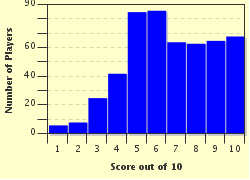Quiz Answer Key and Fun Facts
1. Let's start with rubbish. How does the Great Pacific garbage patch potentially impact on us?
2. What type of extreme weather event resulted in the most US deaths during the 1990s?
3. We have all heard about carbon dioxide and its effect on global warming. What man-made chemical, in common use until the 1990s, is more than 10,000 times more potent as a greenhouse gas than carbon dioxide?
4. "Water, water, everywhere,
And all the boards did shrink;
Water, water, everywhere,
Nor any drop to drink."
How much of the Earth's water, which covers 70% of the planet's surface, is fresh water?
5. From time to time the world undergoes a mass extinction event. Perhaps the best known is the Cretaceous-Paleogene one which took place 66 million years ago and saw the disappearance of dinosaurs amongst other animals. What name is sometimes given to the current one?
6. The world's growing population demands feeding and commercial agriculture has risen to the challenge since the Second World War. This has been achieved in part by the widespread use of synthetic fertilisers. Which industry turned spare production capacity over to making synthetic fertilisers?
7. Exploitation of natural resources usually ignores the cost to the environment. It can also lead to conflict. What was the name of the clash over fish between Iceland and the UK in 1972 and 1973?
8. Population and commercial pressure has led to many native forests being cut down, with negative impacts on the environment. In which country can you find most of the forest known as the "lungs of the world"?
9. Warfare typically has a negative impact on the environment. Which European power was the first to deliberately target trees and crops with herbicides and defoliants (such as Agent Orange) as a military tactic?
10. Which of these gases, typically produced by coal-fired power stations and vehicles, is one cause of acid rain?
Source: Author
suomy
This quiz was reviewed by FunTrivia editor
rossian before going online.
Any errors found in FunTrivia content are routinely corrected through our feedback system.

